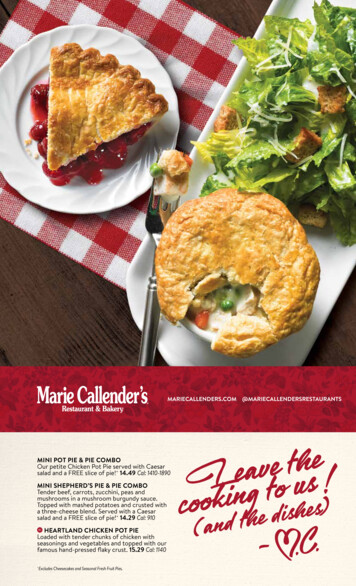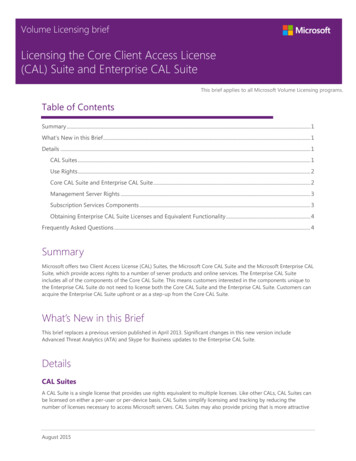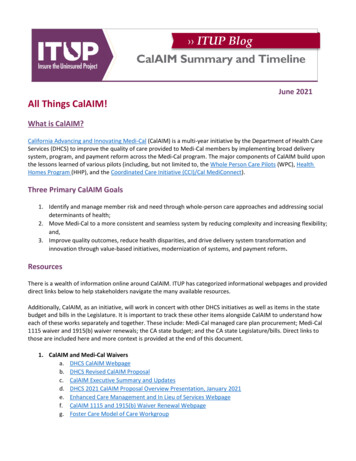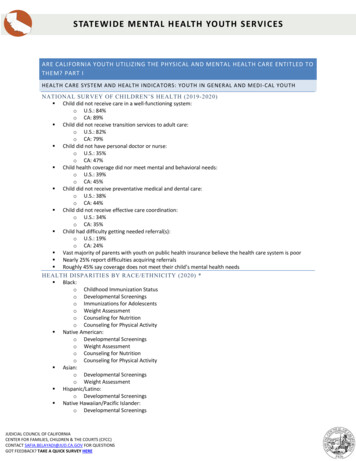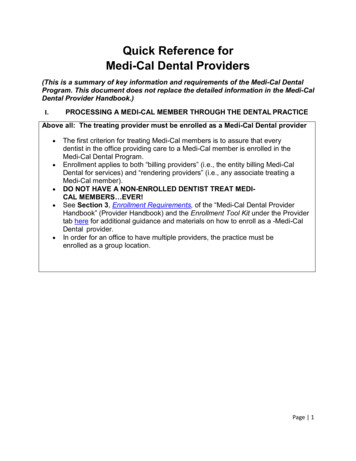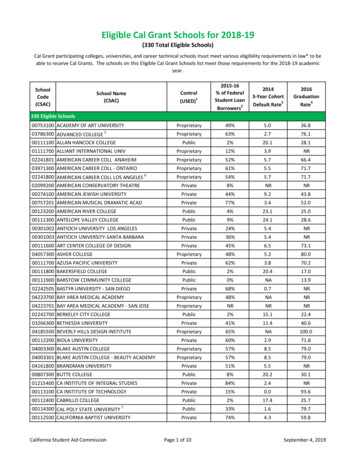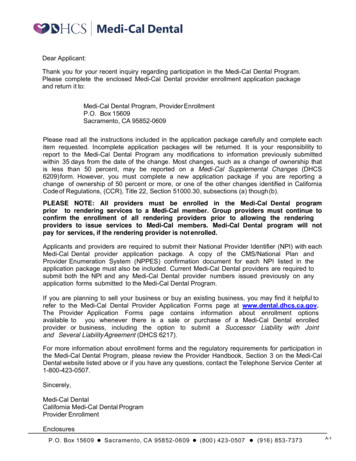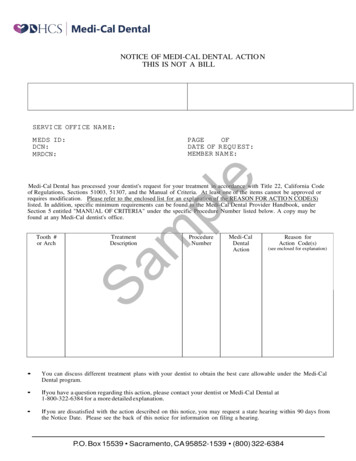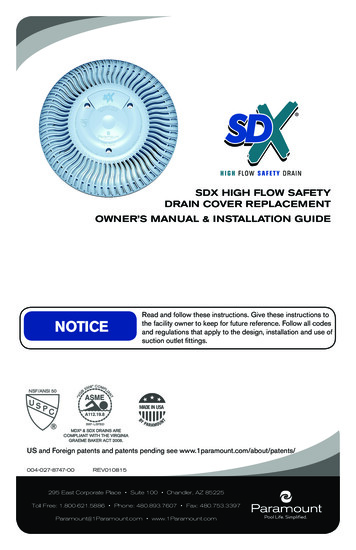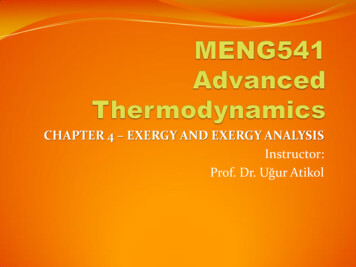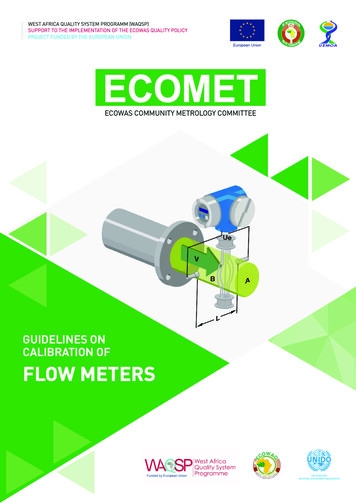
Transcription
1
ACKNOWLEDGMENTSThis document has been published by the West Africa Quality System Programme (WAQSP)implemented by the United Nations Industrial Development Organization (UNIDO), fundedby the European Union (EU), in support to the Economic Community of West African States(ECOWAS). It was prepared under the overall guidance of Mr. Bernard Bau, WAQSP ProjectManager and Industrial Development Officer at the UNIDO Department of Trade, Investmentand Innovation (TII) and the technical coordination of Mr. Aka Jean Joseph Kouassi, ChiefTechnical Advisor of the WAQSP. This document belongs to a series of Metrology guidesprepared by Mr. Paul Date, UNIDO/WAQSP expert in Metrology, and validated by theECOWAS Community Committee for Metrology (ECOMET). We acknowledge the valuablecontribution of the ECOMET members: Mr. Paul Date (chairperson), Mr. Gabriel Ahissou,Mr. Issa Sawadogo, Mr. Jose Antonio Carvalho, Mr. Déza Emmanuel Zabo, Mr. JallowAmadou Tijan, Mr. Sanoussy Diakhaby, Mr. Cesario Augusto Nunes Correia, Mr. SheriffAbdul Rahman, Mr. Drissa Daou, Mr. Boubacar Issa, Mr. Bede Edqu Obayi, Mr. IbrahimaSarr and Mr. Frank Martin. The editing and revision were performed by Mr. ChristopheMarianne. Text formatting and consistency check have been provided by Mr. ChristianLasser and the document has been designed by Mr. Doudou Ndiaye and Mr. OmarTajmouati. Our thanks go out to all the other persons who, although not mentioned here,contributed to the realization of this publication through their constructive comments.ORIGINAL VERSIONThe English language version is the original document. This version will be translated in theother ECOWAS languages. In the event of any contradiction between the terms of thisdocument and those of the other language versions, the original shall prevail. This documentmay not be offered for sale.DISCLAIMERThis document was produced with the financial support of the European Union.Its contents are the sole responsibility of the authors and do not necessarily reflect the views ofUNIDO, the European Union, the ECOWAS Commission or any Member State involved in theproject. 2019 UNIDO - All rights reserved. Licensed to the European Union under conditions.i
Contents1INTRODUCTION . 12STANDARDS. 13CALIBRATION . 24RATE, QUANTITY AND TIME . 35REPEATABILITY AND REPRODUCIBILITY . 56FLUID PROPERTIES . 57FLOW PROFILE . 68TRACEABILITY, ACCURACY AND UNCERTAINTY . 69ACCREDITATION. 910CALIBRATION TECHNIQUE OF LIQUID FLOW METER . 910.1Volumetric calibrators . 910.2Gravimetric calibrators (Static/Dynamic) . 1210.3On-site Calibrators . 1310.3.1Provers . 1310.3.2Operating principle . 1410.3.3Classification . 1410.3.4Calibration of meters using Pipe provers . 1510.4Calibration by master meter method . 1611REPORTING THE RESULT – PERFORMANCE INDICATORS . 1712VERIFICATION OF FLOWMETERS . 2213CALCULATION OF METER ERROR . 23ANNEX1: EXAMPLE OF A TEST REPORT . 24REFERENCES: . 26ANNEX 2: CLIENT CALIBRATION CHECK LIST. 27ii
ECOMET Calibration guide 051G-CAL-005-Flow metersINTRODUCTIONThroughout industry, flowmeter accuracy and repeatability are scrutinized with differentcriteria to ensure confidence in a particular application. In utility environments, for example,a government body may require a flowmeter to meet minimum accuracy and repeatabilitystandards. In others, say private industry for example, in-house specifications are likely thesource for accuracy and repeatability standards. Whatever the case, be it a governmentmandated standard or an internal performance requirement, flowmeter accuracy andrepeatability are of the utmost importance.There are a variety of methods users can employ in an effort to ensure flowmeterperformance, but the terminology for describing such practices is often used interchangeablydespite the unique nature of different practices. In some applications, flowmeter verificationwill satisfy requirements for meter performance within a defined tolerance of the originalmanufactured state. In other applications, however, a traceable calibration is required to fulfillthis requirement. And some other scenarios may require in-field proving of the meter to instillconfidence in its performance in a specific system. These techniques, which are the mostprominent methods for ensuring flowmeter accuracy and repeatability, have inherentdifferences and can be a good fit in many environments, depending on the requirements ofthe application.2STANDARDSFluid flow rate standards could be significantly simplified if the fundamental bases of thesemeasurements were as simple as those for mass, length and so on. These systems ofmeasurement are based upon discrete standards or artifacts. These artifacts can beconsidered identity standards.The mass and length artifacts can be considered identity standards because under theappropriate conditions of use they define the basic quantity in their respective measurementSystems.However, the flow rate measurement of fluids does not exist as an identity standard such asgallons/minute, m³/hr, gm/sec, etc. To supply the fundamental basis upon which to establisha flow measurement system, a derived standard is required.For fluid flow rate measurements, as needed to form the basis of a reference system, thelaboratory is maintained for use by industries and others with respect to:-Calibration by Master Meter Method-Calibration by Volumetric MethodSuch laboratory generally consists of:-A source of flow, generally a pump, a blower or a constant head tank with appropriateauxiliary equipment.-A test section into which the meter and its adjacent piping can be installed so that theflow and fluid conditions into it duplicate those expected where the meter will actually beused; and1
ECOMET Calibration guide 05-G-CAL-005-Flow metersA flow determination system having a specified level of performance and appropriateproof of traceability to specify and assure the desired metering performance of the devicesin question.The heart of the fluid flow meter calibration facility is the flow determination system. Thisgenerally uses a timed collection of the fluid that flows through the meter being calibrated.This collected fluid is converted to flow rate using the collection time, the volumetric flow ratethrough the meter can be determined via the corresponding temperature and density. Thesystem can be operated with suitable means at a high-level performance to determine thebulk flow of the fluid.3CALIBRATIONCalibration is a comparison between the reading of a device and that of a standard. Theprocess which establishes this relationship is a set of interrelated measurements andoperations which provide the comparison. Flow measurement does not rely on a singleoperation and so neither does a flow-based calibration.Measurement of the quantity of fluid depends on establishing the basic quantity and anumber of influence factors. The quantity of fluid may be expressed as a volume or a mass.The measurand may be the quantity or the ‘rate’ i.e. the quantity per unit time. The quantitymeasured by the standard may be different from the quantity passed through the test devicedue to changes in volume or even mass between the meter and the standard. Changes areusually related to the influence factors such as temperature, pressure, viscosity andexpansion. This combination of fluid, influence factors, the standard and the device cometogether to define a set of operations which is to provide the calibration.As the fluid and influence factors all affect the meter performance, the calibration is carriedout ‘under specified conditions’ and these must be defined.A calibration is not an absolute operation. It is a comparison between the measuringinstrument, in this case the device under test or flow meter, and the standard. Through thiscomparison, a relationship between the quantity measured by the device under test and themeasurement of the same quantity derived from the standard is established. This isexpressed in some way which gives a meaningful expectation of how the device will performin use.The comparison during a calibration is against a standard. The standard comprises thesystem of pumps, pipes, fluids, instrumentation, quantity reference measurement,2
ECOMET Calibration guide 05G-CAL-005-Flow meterscalculations and operators. These all combined provide a measure of the quantity of fluidpassing through the device or flow meter being calibrated.The measurement of fluid flow is dynamic and all measurement devices are affected in someway by the conditions of use. It will be impossible to have a standard which fully reproducesthe conditions under which the meter will be used in practice. Flow devices are affected bytemperature, viscosity, flow profile, flow rate fluctuations and pulsations. They are alsoaffected by the external environment, vibration, stress and temperature, etc. Differentdevices are affected in different ways. Similarly the standard will also be susceptible to thesesame influences.Since a calibration is a comparison between the measurement made by the device undertest and that realised by the standard, the resultant relationship will be for the specifiedconditions; therefore a further assessment of the relevance to the final application must becarried out. Selecting the standard will be a compromise to best replicate the conditions ofuse while providing a suitable reference standard measurement. The standard must also becompatible with the performance and characteristics of the meter to be tested and the resultdesired.The extent to which a flow measurement device is affected by the conditions of use is mostoften a function of the flowrate. It is therefore important that calibration takes place across arange of flowrates to establish this relationship.4RATE, QUANTITY AND TIMEThe mechanism by which a flow measurement device gives a reading of flow is dynamic.The sensor reacts to the flow of fluid through it or past it to realise an output related to theflowrate or the quantity passing.Measurement of flowrate and quantity are related through the time interval across which thequantity is measured. In practice, the end user of the device has different expectations forthe behaviour and hence the calibration. In establishing this relationship, it is vital to relatethe response time of the device to the calibration method. Again, the current and oldergeneric definitions of response times are given.The interpretation of response time is reasonably straightforward for mechanical meters. Themechanical interface between the fluid and the indicator can be explained and defined interms of momentum and drag affecting the meter when the flow changes. With the adventof electronics this has become more difficult to establish. For example, a positivedisplacement meter in liquid responds very quickly to changes in flowrate even very abruptchanges; the flow stops, the rotor stops and the register stops. If a pulse generator is fitted,the generated pulses stop when the flow stops. A frequency counter will not reflect this untilit completes its measurement cycle which may be some seconds later. During that time, a3
ECOMET Calibration guide 05G-CAL-005-Flow meterstotalizer or register will correctly indicate quantity, but the flowrate indicator will not beshowing the correct (instantaneous) flowrate. If however the mechanism in the meter hasplay or is loose, stopping the rotor may allow the output register to run on after the rotor stopshence generating additional quantity or pulses.A different type of meter may of course not respond to an immediate change in flow. A turbinerotor will have significant momentum and, although speeding up quickly, may take time toslow down when subjected to a change in flow, particularly in gas measurement. Metersbased on non-mechanical sensing techniques e.g. electro-magnetic, Coriolis or ultrasonicmeters, have different response characteristics. For example, an electromagnetic meter maytake some time to establish and measure a change in the generated voltage after a changein flow, while an ultrasonic meter output is the average of a number of measurement cyclesand this averaging may take appreciable time to complete.Most meters based on non-mechanical sensing, and some mechanical meters, have amicroprocessor which calculates the output quantity from the sensor signal. For some metertypes this is an additional capability while others require this processing to convert the sensorsignal and correct for influence factors before calculating and generating an output signal.The output signal can be a pulse frequency or a current (mA) output generated from thiscalculation process.A digital display may be added to show the required output value and many modern metershave digital outputs to transmit the chosen measurement(s) to a remote readout or computer.All these outputs will have a different response times delaying the raw sensor response bythe signal processing and calculation time.An example of a processed output signal comes from a vortex meter with a signal processordesigned to smooth any pulses missed by the sensor and to increase the resolution of theoutput. Such a device may have output response times of many seconds even though thesensor itself has responded in under a second.Modern flow meter types such as Coriolis, electromagnetic, or ultrasonic meters are totallydependent on microprocessor-based output, and the variety of settings to average, damp orcut-off low flowrates must be understood and selected to ensure the response time matchesthe limitations of a calibration method. Matching the response time of a device to the chosencalibration method is a vital part of the process. If the device response time does not matchthe time within which a calibration test point is taken, poor repeatability or calibration offsetsmay be observed. This response time may however be perfectly adequate or evenadvantageous when the meter is in service.4
ECOMET Calibration guide 055G-CAL-005-Flow metersREPEATABILITY AND REPRODUCIBILITYTo obtain confidence in a measurement it is expected that the measurement should be ableto be repeated and give the same result. In practice measurements only repeat to within acertain band over a short time and a (probably) wider band over a long time period or underdifferent circumstances. It is generally expected that a calibration should give someindication of the repeatability of an instrument; however it is not likely that one calibration willshow the reproducibility. Repeated calibration may of course be carried out perhaps overmany years to show this parameter.A measurement standard should have determined repeatability and reproducibility figureswhich will have been included in the uncertainty determination. The repeatability of acalibration will of course include the repeatability of the standard, but also the repeatabilityof the device under test. A large part of the repeatability will be the resolution of both thedevice and the standard.It is interesting to note that a device or flow meter may be believed to have better repeatabilitythan that of the standard. This belief is based on history, behaviour in other calibrations andservice etc. The repeatability cannot however be proved to be better as it can only bedemonstrated through repeated calibrations against the standard.6FLUID PROPERTIESAll flow meters interact in some way with the flowing fluid. The nature of this interaction isaffected by the properties of the fluid or the velocity distribution of the fluid passing throughthe device. Changes in this interaction alter the ability of the device to give an accuraterepresentation of the quantity. The magnitude of the error is different for different meter typesand fluids.For this reason it is desirable to calibrate using the same fluid and pipework configurationwithin which the meter will normally operate. This is clearly not often possible; the meter hasto be installed in a test laboratory, or the calibration standard has to be installed in the samepipework as the flow metre under test. In either case some degree of disturbance to the meteris inevitable. The best economic compromise must be established in choosing the calibration.This will be based on the final duty of the meter, the required uncertainty and knowledge ofthe meter performance. For some meters, for example orifice plates, the performance canbe related to Reynolds numbers. This allows a calibration to be carried out in a fluid differentto the meter‘s operating fluid. The relationship may even allow a liquid calibration to beapplied to a meter for a gas duty by matching Reynolds numbers.5
ECOMET Calibration guide 05G-CAL-005-Flow metersFor other meter types, such as turbine meters, the choice of calibration fluid is particularlyimportant. Turbine meters are viscosity sensitive, and the figure opposite shows some typicalcalibration results from a turbine meter using water and three petroleum products. Becauseof this sensitivity to viscosity it is important to calibrate these meters using a fluid as close tothe viscosity of working fluid as is practicable. For this reason, among others, fiscal metersfor oil are often calibrated on site using a dedicated pipe prover.For gas meters, air is often used as the calibration fluid for safety reasons. When used withother gases the performance related to Reynolds number provides a good relationship forturbine and ultrasonic meters. Coriolis, and positive displacement meters do not follow thisrelationship. For variable area meters it is important to correct the gas density to a standardcondition to match the scale. Gas pressure is probably the most important influence factoras this affects the density and hence many aspects of a meter performance.Properties of the fluid such as density, temperature, conductivity, pressure may also have tobe considered when replicating the use of the meter in a calibration.7FLOW PROFILEWhen a fluid passes through a pipe, the distribution of velocity across the pipe alters toapproach a fully developed profile which is dependent on the pipe internal diameter,roughness and fluid Reynolds number. The presence of any change from a straight pipe willalter the profile drastically. Bends, double bends, valves, etc. all introduce asymmetry to thevelocity distribution and some introduce swirl or rotation. As the way the fluid interacts withthe sensor can be highly dependent on the velocity profile, these effects must be consideredin the calibration. Most calibration facilities allow adequate straight pipe lengths and the useof flow conditioners to establish predictable and reproducible flow profiles close to an idealprofile. It should be noted however that care has to be taken to ensure pipes upstream of themeter have the same internal diameter as the meter inlet and step changes or misalignmentof joints and gaskets do not introduce irregular profiles.8TRACEABILITY, ACCURACY AND UNCERTAINTYSince a calibration is a comparison between the reading taken from a device under test andthat of a standard, it is necessary to consider what properties are required from a standard.Firstly and most importantly, the standard should measure the same quantity as the device.There is little value in comparing a mass meter output with that of a volume tank without ameasure of density to allow conversion between mass and volume. For flow measurement,the standard is a system comprising of a measure of quantity and the subsidiarymeasurements to determine the fluid conditions, properties and influence factors.6
ECOMET Calibration guide 05G-CAL-005-Flow metersAnother feature of the standard is that there must be confidence that the measurement takenby the standard is accurate. To achieve this all the measurements in the system have toshow traceability to higher level measurements and ultimately to National and Internationalstandards.The definition of traceability provided expresses the process by which a measurement canbe related through an unbroken chain of comparisons to national/international standards. Itmust be noted that each step of the chain will have an uncertainty becoming smaller at eachstep. It must be noted that providing or claiming traceability alone makes no statementregarding the quality or uncertainty of the result; this requires an uncertainty value.Traceability must also be through comparisons to other/better calibrations and NOT TO anaccreditation body. It is contentious to use the term ‘accuracy’ in relation to calibration work.Accuracy does not have the rigour or precision required to describe a scientific process. Inpractice however accuracy, when used correctly, is the term to which users relate and canusefully be employed to express expectation and general specification. Accuracy is aqualitative term and therefore the number associated with it should be used for indicativepurposes.To correctly express the accuracy of a standard or a calibration, the uncertainty must bedetermined and quoted. Uncertainty provides confidence that the determination of the valuelies within the stated value. For flow measurement, the confidence in the result lying withinthe uncertainty is normally quoted with a coverage factor of k 2, which is approximately 95%confidence level. A full explanation is given in the Guide to Measurement of Uncertainty(GUM) or ISO 5168.Every standard must be assessed for the uncertainty in the determination of its measuredquantity, as indeed must the result of a calibration.The uncertainty quoted for a calibration or a standard will be estimated from a detailedexamination of all the components within the system, the use of the system and its history.It will specifically state for what parameter the uncertainty applies to. This parameter may bethe quantity measured by the standard or the quantity passed through the device under test.The latter is the uncertainty which is needed initially. It is stressed that this is not theuncertainty of the calibration result. The resolution of the meter, the influence factors andfinally the repeatability and linearity of the calibration results must all be included to providethe uncertainty of the calibration result.The purpose of a calibration is to estimate the uncertainty associated with measurementsfrom the meter in its final application. It is clear that the calibration will only provide acomponent of this final measurement uncertainty. A responsibility remains with the end userto use the calibration uncertainty along with an understanding of the use of the metercompared with the calibration conditions to provide this final result.7
ECOMET Calibration guide 05G-CAL-005-Flow metersAll calibration results should have a stated uncertainty and this should be stated clearly onthe calibration report or certificate. The uncertainty statement should be clear andunambiguous as to what is included and which quantity it refers to. Uncertainty can beexpressed on the certificate as being the uncertainty of the measured quantity (flow, volumeor mass) or uncertainty of the device under test during calibration.An equation fitted to the data, if provided, should also have a stated uncertainty estimated.The uncertainty will not include the estimate of uncertainty at different time or conditions. Anyestimate at a different time or condition is an estimate (or speculation) and could only beadvisory and not part of the calibration.It is also worth noting that uncertainty may vary across the flow range of the meter. Thequantity of fluid collected by the standard may contribute to different uncertainties, or themeter performance may vary.In specifying the required uncertainty of a standard relative to that of a meter, it is goodpractice that the standard should have an uncertainty 10 times smaller than that of therequirement of the device to be calibrated. Although this is a good principle, in flowmeasurement it is often not achievable due to the high expectations of flow meters and theapplications for them. A standard with an uncertainty of a factor of three lower than therequirement of the application is often all that can be achieved.In some situations, especially in field testing, the uncertainty of the standard may be higherthan the expected uncertainty of the meter. This applies when some methods of in-situcalibrations are called for. When this occurs the achieved uncertainty of the calibration mustbe larger than that of the standard, hence increasing the uncertainty of the finalmeasurement.When this situation is encountered, verification rather than a calibration is often specified.The result is used to provide increased confidence that the meter is operating correctly butnot used to make corrections to the meter or as the primary assessment of its uncertainty.It is to be noted that uncertainty should not be confused with error. Error expresses how faraway from the true value the reading is; however, this value may be known to have a muchsmaller uncertainty. Knowing the error may allow a correction to be made to the reading.8
ECOMET Calibration guide 059G-CAL-005-Flow metersACCREDITATIONAccreditation is the process that a calibration laboratory or service provider undergoes togive confidence that the results provided to their clients meets the expectations stated in thescope of the work.It is a process by which the equipment, technical methods, contractual arrangements, andquality of the results are examined to give confidence to the client in the delivery of theservice. A third party, or indeed the client, accredits an organization, hence giving confidencein future works without individual inspection. This process ensures that traceability has beenestablished, an uncertainty budget produced, and procedures are sound.To avoid multiple client accreditations, and to provide commonality, accreditation is providedby a National accreditation body and subject to meeting international agreements on thestandards for inspection. Most developed countries have their own accreditation body and itis now recommended that only one body should be appointed in each country.10CALIBRATION TECHNIQUE OF LIQUID FLOW METEROne characteristic of a liquid is that it can be contained in an open vessel and several liquidflow standards make use of this by causing the liquid to flow throughout t h e meter to becalibrated into a collecting vessel, master meter, and then determining the mass or volumeof the liquid collected, when at rest. Types of calibrators used: Volumetric calibrators Gravimetric calibrators On site calibrators10.1Volumetric calibratorsThe measurement of the quantity of liquid collected may be carried out volumetrically bycollecting a known volume of liquid in a container. In the volumetric method the standardvessel takes the form of a container with a calibrated volume. Normally this will be a vesselwith conical ends to facilitate drainage and to reduce the risk of air entrapment. The neck ofthe vessel is normally fitted with a sight glass and a scale marked in volumetric units. A typicalvolumetric tank is shown below. Various shapes of vessel are used. Inclined cylindricalvessels with necks at opposite ends are one design, as are simple cans with no bottom drainand the level being established at the top brim. This latter type is used for the calibration offuel dispensers.9
ECOMET Calibration guide 05G-CAL-005-Flow metersThe tank volume must be determined by calibration of the vessel. This can be carried out byweighing the water contained in t
3 CALIBRATION Calibration is a comparison between the reading of a device and that of a standard. The process which establishes this relationship is a set of interrelated measurements and operations which provide the comparison. Flow measurement does not rely on a single operation and so neither does a flow-based calibration.
